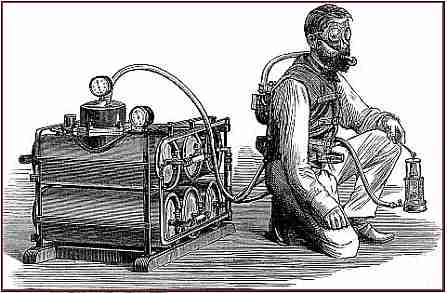|
Louis Denayrouze
(1848 - 1910)
French engineer, inventor and dramatist whose inventions included a partly self-contained diving system which contributed to the development of the scuba apparatus used by divers.
|
Louis Denayrouze's Aerophore for Mines
from Nova Scotia Department of Mines Annual Report: 1873
An apparatus, invented by M. Denayrouze called an aerophore, has lately attracted much attention in England, and the tests made have proved it to be of practical value for just such service. By its aid, says the inventor, a man, encumbered by no more than 8 or 10 lbs. weight of apparatus, may penetrate at once and to a great distance into a pit filled with choke damp or any other gas, remain there for several hours, carry a lamp with him without danger, and have free use of his arms. The apparatus is of two kinds; a low pressure apparatus, which requires that air should be pumped to the miner through india rubber tubing from the nearest point at which pure air can be found; and the high pressure apparatus, which enables the miner to carry his own supply of fresh air in a receiver, and thus make him independent of communication from without. So satisfactory were the experiments considered, that the apparatus was regarded as invaluable for enabling a miner to explore a working charged with gas or to recover a man who could not otherwise escape, and orders were at once given for several to be kept at the collieries in the neighbourhood of the place where the experiments were made.
From: Nova Scotia Department of Mines Annual Report: 1873. (source).
A.D. 1872, July 17.— [Great Britain Patent] No. 2142.
Improvements in apparatus for supporting respiration and light in suffocating or explosive atmospheres.
This invention relates to apparatus for furnishing a regulated supply of air for respiration and light to miners, and others employed in a suffocating or explosive atmosphere, and to lamps used in connection therewith.
Reservoirs charged with compressed air either stationary or conveyed in trucks or carried on the back are provided with regulating chambers wherein flexible diaphragms subjected to atmospheric or other desired pressure act on valves so as to govern the issue of air from the reservoirs at the pressure desired,
The air thus issuing conveyed by flexible pipes is used to support respiration and the combustion of the lamps.
In supplying the reservoirs by pumps the air is sifted of dust and grit by passing it through a screen of felt or other porous fabric.
The lamp has a double casing of metal with glass on one side. The air supplied to the space between the casing serves to cool them and is itself heated before reaching the flame. The products of combustion escape by an aperture fitted with a light valve closing inwards, and with diaphragms of wire gauze to prevent communication of flame to explosive gases without.
Patent abstract from Bennet Woodcroft, Clerk to the Commissioners of Patents, Great Britain, Chronological and Descriptive Index of Patents Applied for and Patents Granted, Containing the Abridgements of Provisional and Complete Specifications For the Year 1872 (1873). (source)
THE AEROPHORE
from The Science Record (1875)
This is an apparatus for enabling persons to breathe and work, with a light, in unbreathable and explosive gases in mines, wells, sewers, and caverns. It is the invention of Messrs. Denayrouze, of Paris. The aërophore consists of a number of large or small cylinders, as desired, which are lowered into the mine with the workman. Connected with the cylinders is a long flexible tube about an inch in diameter, of such strength that it can not be damaged even by being trod upon. The person who is to use the aërophore first puts on a strongly-made jacket of webbing, to the back of which is attached a couple of moderating valves, which serve to supply the compressed air to the mouth at ordinary atmospheric pressure—not higher—the pipe being attached to these valves. Another pipe passes over the shoulders and to a mouth-piece. The nostrils are closed by a nipper. The mouth-piece is constructed so as to be available either for a light or heavy breathing man. Exhalation is accomplished by means of a small aperture in the tube about two feet from the mouth. This aperture is fitted with a proper valve, which stops the ingress of all air or gases. By another valve and tube, air is supplied to the lamp which the miner carries in his hand, and enables it to burn brightly, and a pair of “goggles” are provided in case the eyes are likely to be affected. These can readily be fastened on by means of an elastic strap.
- Today in Science History event description for a test of the aerophore on 12 Jan 1875.





